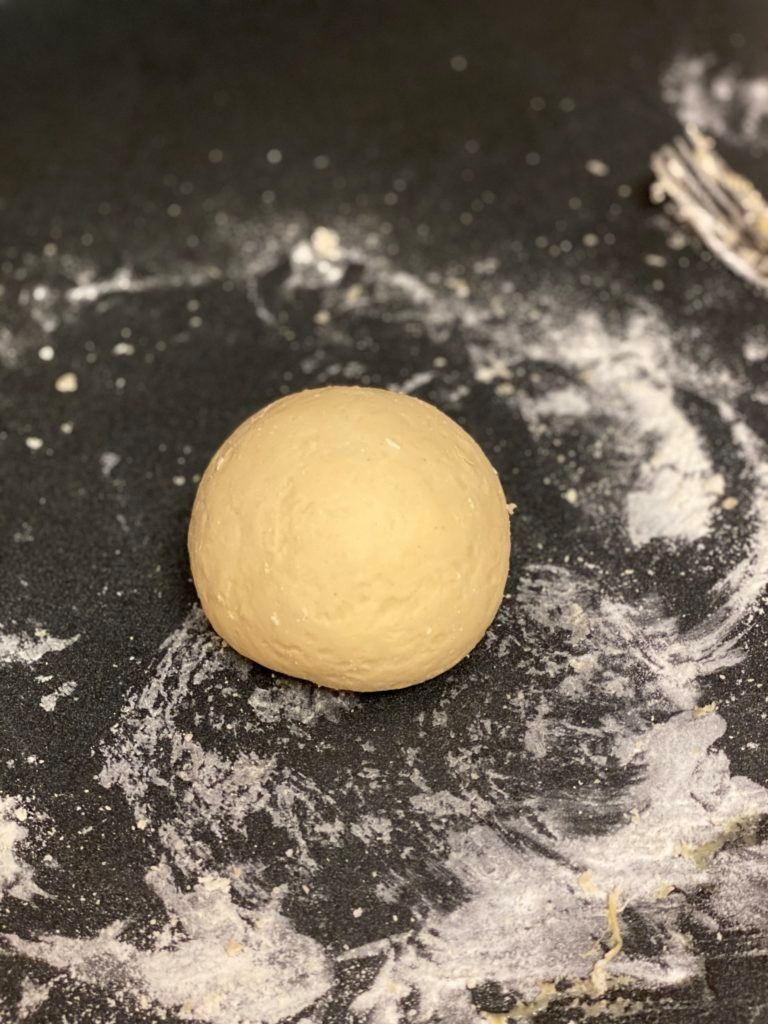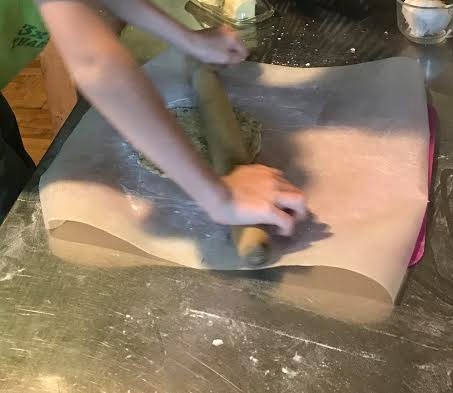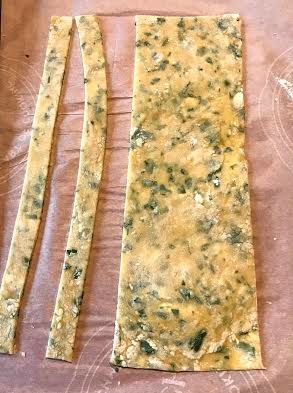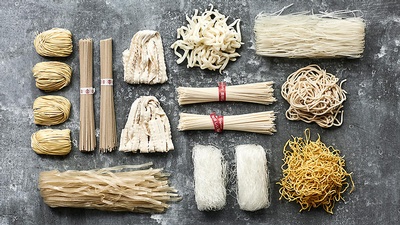Thank you to Nourishing Literacy (NL) team member Carolyn for writing this blog post! In addition to sharing her experience and findings, Carolyn has included some of the activities and approaches that we use in NL. The NL team enjoys providing interactive food info and ideas that spark curiosity and are inclusive to all ages and skills. Noodles are a great vehicle for vegetables and lean protein, and can be enjoyed in so many different ways. What kinds of noodles have you enjoyed or might you like to taste?
Nourishing Noodles
As a mom to a young child and a pasta-lover, one of my favorite children’s books is Strega Nona. Winner of a Caldecott Honor for illustrations, Tomie de Paola’s classic features a magic pasta pot that produces enough spaghetti to nearly bury a town. Fun for all ages and a great way to introduce young readers to Italian noodles, this book is available to check out with your Free Library card in English, Spanish, and for download as an audiobook.
To this day, I crave chicken noodle soup when I come down with a cold. If I’m hosting a lunchtime playdate for my son, mac and cheese will be on the menu. Spaghetti with meatballs, noodles with shrimp, and pesto pasta are among the go-to meals that I cook for my family.
Noodles Across Cultures
Comforting, nourishing, filling, easy, adaptable—noodles are a staple across tables with good reason. Vibrant and culturally rich, Philadelphia is home to people and traditions from around the world. Each day, in kitchens across the city, families prepare a stunning variety of noodles in many ways, from Vietnamese pho to Thai dishes like pad see ew and pad thai, Japanese ramen, Chinese lo mein and chow mein, Jewish noodle kugel, Mexican sopa de fideo, West African-style peanut sauce over Udon noodles, and more.
Want to dive deep into noodle varieties and dishes from different cultures? You might begin with Wikipedia’s Noodle page, which includes a basic definition of the noodle, "a type of food made from unleavened dough which is rolled flat and cut, stretched or extruded, into long strips or strings," a bit on the noodle’s origins and evolution over time and place, and a list of varieties according to the base ingredient: wheat, buckwheat, egg, rice, and other varieties made from acorn meal, mung bean or potato starch (or related starches), seaweed, corn, kudzu root starch, and Japanese konjac ('devil’s tongue'). A separate list of noodles identifies noodle types by country, and yet another list of noodle dishes provides well over 100 noodle dishes by region and country, from Burma to Cambodia, China, Europe, Indonesia, Japan, Korea, Laos, Malaysia, the Philippines, Singapore, and Spanish-speaking countries, Thailand, Tibet, the United States, and Vietnam. And among the Free Library’s many resources on noodles is Brian Yervin’s A World of Noodles, which introduces readers to noodles around the world. Use your library card to place a hold on this book and request pick up at a neighborhood library near you.
Making Noodles From Scratch
Boxed or bagged, dried noodles from the store are accessible, affordable, shelf-stable, and can be both quick to prepare and satisfying to eat. For these reasons, I’ve never made noodles from scratch before. After trying to prepare noodles recently, I learned that handmade noodles can be engaging and fun to make, for all ages! This project can take up to two hours, which might make it more of a special occasion recipe than an everyday one.
I turned to Alice Waters’ cookbook The Art of Simple Food (available for physical checkout with your library card), for my first attempt at handmade pasta. I made tagliatelle, a long and flat noodle, though you can make many different shapes with this dough. This recipe calls for two eggs and two egg yolks, but I found that three eggs work just fine. Chopped parsley brought a subtle flavor and an added moisture that made the dough a bit softer and easier to work with. If you happen to have parchment paper, rolling the dough between 2 floured sheets can help you get the dough extra thin. My son joined me in rolling and he found that standing on a chair put more oomph in his roll. I dried some noodles on a cooling rack and others on a table, and they all turned out well.
Making noodles from scratch can involve trial and error and patience. Noodles made by hand will likely look and taste different than those purchased from a store or restaurant. This can make them special and unique. My handmade noodles were thicker than the boxed ones I’m used to, but they were delicious. We topped them with sautéed shrimp and grated cheese, and my family finished four servings between the three of us. We can’t wait to make (and eat) them again!
Here are the ingredients needed to prepare these noodles. What might you add on top of your noodles?
- 2 cups flour
- 2 eggs and 2 egg yolks (or 3 eggs)
- ¼ cup chopped fresh parsley (optional)
If you have dietary restrictions or food allergies, making your own noodles is also a great way to explore alternatives to the more common varieties. And with a peeler, a knife, or a box grater, you can turn almost any vegetable into a noodle. Below you’ll find more resources with recipes and tips for making your own noodles from scratch.
Free Library Resources
Want to read and learn more about noodles? The Free Library has lots of resources on cooking with noodles and preparing your own, as well as children’s stories and nonfiction books centered around noodles. Check out any of the resources below with your library card, or go to our catalog and enter the search term "noodles" to find more inspiration.
Let’s Make Ramen by Hugh Amano and Sarah Becan is another great noodle resource appropriate for all ages. Equal parts graphic novel and cookbook, this is an accessible introduction to ramen and Japanese cuisine, with easy-to-follow recipes suitable for beginner cooks.
Do you like reading biographies or memoirs? In On the Noodle Road: From Beijing to Rome with Pasta and Love, food writer Jen Lin-Liu charts her travels from China to Italy in search of noodles and their history. As you read along, you might even think about creating a "noodle road" through our vibrant city, visiting neighborhoods, and sampling noodle dishes from the many different cultures represented in Philadelphia. Available as an audiobook with your library card, this culinary travelogue includes recipes too.
If all this reading about noodles is making you hungry, you’ll find plenty of ideas and cooking tips in Aliza Green’s Making Artisan Pasta, Andrea Nguyen’s The Pho Cookbook, and Jonathon Sawyer’s Noodle Kids: Around the World in 50 Fun, Healthy, Creative Recipes the Whole Family Can Cook Together. All three books are available for digital download with your library card.
Go Noodle
Go Noodle is a free online program that engages millions of youth each month with movement and mindfulness-based games in English and Spanish. This is a wonderful resource to keep the entire family active, breathing deeply, and learning together through fun, playful games.
Philadelphia Noodles
Philadelphia’s Chinatown is a great place to explore and sample different varieties of noodles, with its plentiful shops and many affordable restaurants. The Nan Zhou Hand Drawn Noodle House is a great stop for handmade noodles that hail from Nan Zhou, known as the "Golden City" in its former heyday as the first stop on the Silk Road trade route. Chinatown is also home to so much more than Chinese food—you’ll find cuisine and ingredients representative of cultures from Vietnamese to Malaysian, Cambodian, Thai, Burmese, Japanese, and Korean.
Storytelling Activity: Noticing Noodles
Think of, write down, or draw some images, words, and / or ideas that come to mind around "noodles." Using your imagination, create a story that includes noodles, while also being personal to you, your interests, and / or your culture. Try to incorporate the following elements into your story: a beginning and end, memorable characters, and a conflict and resolution. You can write your story down, draw a picture of it, or express it verbally. If possible and of interest, try creating an audio recording of your story. As you listen back, is there any part of the story that you would like to change? Anything that you would like to add?
For more inspiration, check out our most recent Nourishing Literacy short learning video about tomatoes, which includes a quick recipe using noodles, as well as some storytelling ideas. Whether you noodle on cooking, eating, writing, or reading today, perhaps the noodle can be an inspiration for you!
Nourishing Literacy offers food, literacy, wellness, and life skills activities and programs to youth and intergenerational community members. To learn more about the Culinary Literacy Center, please visit our website or connect with us through Instagram and Facebook.
Have a question for Free Library staff? Please submit it to our Ask a Librarian page and receive a response within two business days.




